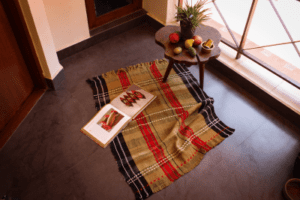
“I once walked with a shepherd who was herding close to 200 sheep on a farm. As the day drew to a close, he made some unique — almost weird — noises and it was amazing to see all the sheep turn around and follow him,” says textile connoisseur Pavithra Muddaya.
Muddaya is the founder of Vimor Handloom Foundation and Vimor Museum of Living Textiles. She has been working closely with the pastoral community aka Kurubas of Karagaon village in Belagavi, Karnataka, to preserve their ancient tradition of kambli or blanket-making, along with enhancing their designs and creating a market for them while empowering the weavers.
The kambli woven by the Kurubas is a true lesson in sustainability and is an integral element of their religious and social life.
Native to North Karnataka, Kurubas are a community of shepherds, who are mainly into sheep penning, agriculture, and trading. They herd their sheep into farm lands where they leave them overnight or for a couple of days. The excreted matter of these animals serve as organic manure and improves the fertility of the soil tremendously.
Once the sheep grow, they are sheared for wool. This thick black Deccani wool is used to weave thick coarse blankets or kamblis, as they are called in Kannada.
“As soon as a child is born, they tie a black woollen thread around the hand of the baby. Whether it is a wedding, festival or even a religious event, the kambli is a regular fixture. Even when the farmers allow the sheep to graze on the field, they carry a kambli to sit and also use it cover themselves in the night. They also use it as a palanquin cover in festivals and religious processions that are held in honour of their deity Beeralingeswara,” explains Muddaya.
The Kurubas consider the practice of weaving the kambli sacred and a duty towards their God, she adds.
According to Muddaya, the entire process of blanket weaving practised by the Kurubas is the epitome of sustainability.
While we hear of terms like zero carbon footprint and eco-friendly practices, it is a revelation to note that the Kurubas have been practising this quietly all their life, she says. They set up a makeshift loom by simply assembling a set of 8 sticks in a 2×2 pit. There is no use of synthetics, chemicals or plastic and there is minimal use of machines.


“For example, the women folk process the wool using thigh reeling and the gum used for the sheep hair is made from the paste of dried tamarind seeds. This is applied using a brush made from the dry tree roots,” quips Muddaya.
The Kurubas use their fingers for measurement and considering that the whole process is handmade, they are able to weave only 10 metres a day.
Muddaya has been working with the community in Karagaon since 2019. Her aim is to not only preserve this tradition but also enhance the design, look and feel of the blankets. The objective of giving the blanket a contemporary touch is to make it more marketable and appealing to the modern-day customer.

Muddaya has introduced a couple of colours like white, khaki, and red that are available locally. (Supplied)
She has been working with 87-year-old Nilakant Nagappa Kurubar to understand the pastoral way of life. In addition, she has been training Shankar Ningappa Sannakki and his son to introduce new colours, blend it with other materials and improvise on the basic designs.
The fact that weaving is not their main source of income and the Kurubas do it only on a need basis made the exercise challenging initially.
“The village had close to 100 looms. But now the number has reduced to a trickle. Also, earlier, the Indian Army purchased the blankets. However, with the loss of that market, the number of weavers reduced further,” mentions Muddaya.
The original blanket is black in colour with the texture being extremely coarse and thick. Muddaya has introduced a couple of colours like white, khaki, and red that were available locally. She has worked on improvements in the design by combining white wool with the black.
Furthermore, she has been experimenting with blending the wool with natural materials like cotton. Besides this, she has also worked with recycled silk to make the kambli soft and scratch free on the skin.
Ensuring sustainability, preserving the essence of the original weave and the spirit of the whole tradition was sacrosanct during the process of training and upskilling.
Currently there are close to 40 people from the community who have been working to craft smaller-sized blankets. They work well as rugs and wall hangings too. Muddaya has also experimented with bags and jackets.
During Covid, food, medicines, and other essentials were supplied to the community.
Apart from training and providing insurance, assistance with marketing is provided. Additionally, there are ongoing experiments for making garments with the fabric.
The pastoralists have been upbeat about the initiative. Also, Muddaya has received training requests from the Kurubas of the neighbouring villages.
They recently showcased these products at an event and the response has been very encouraging.
“There is good demand for these products which augurs well for the community as a whole. We ensure that the revenue is distributed to everyone contributing towards the making of the end product — be it a person setting up the loom, a person doing the thigh reeling and an actual weaver,” concludes Muddaya.

Jul 26, 2024

Jul 26, 2024

Jul 25, 2024

Jul 25, 2024

Jul 25, 2024

Jul 25, 2024